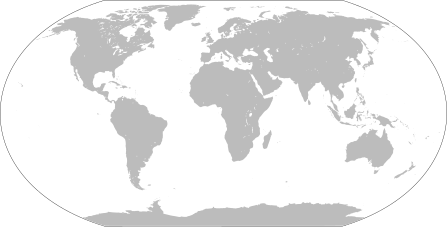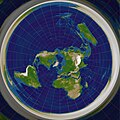This is an old revision of this page, as edited by Junglecat (talk | contribs) at 23:27, 28 April 2009 (Reverted edits by Test413 (talk) to last version by ClueBot). The present address (URL) is a permanent link to this revision, which may differ significantly from the current revision.
Revision as of 23:27, 28 April 2009 by Junglecat (talk | contribs) (Reverted edits by Test413 (talk) to last version by ClueBot)(diff) ← Previous revision | Latest revision (diff) | Newer revision → (diff) For other uses, see World (disambiguation).| WorldTerra, Earth, Zemla, Земля, Erde, Terre | |
|---|---|
 | |
| Demonym(s) | Earthling, Terran |
| Area | |
| • Total | 149,000,000 km (58,000,000 sq mi) |
| Population | |
| • 2009 estimate | 6,750,000,000 |
| • Density | 45/km (116.5/sq mi) |
| GDP (PPP) | 2008 estimate |
| • Total | USD $70.650 trillion |
| • Per capita | USD $9,600 |
| GDP (nominal) | 2007 estimate |
| • Total | USD $55 trillion |
| • Per capita | USD $8,100 |
| HDI (2006) | 0.747 high |
World is a common name for the planet Earth seen from a human point of view, as a place inhabited by human beings. It is often used to signify the sum of human experience and history, or the 'human condition' in general.
In a metaphysical context, World may refer to the Universe, everything that constitutes reality: see World (philosophy)
Etymology
In English, the etymology of world may be a compound of the obsolete words were, "man", and eld, "age"; thus, its etymology would be semantically rendered as "age or life of man". Compare to the word for "world" in a closely related language to English, Dutch, which is "wereld."
Usage
'World' distinguishes the entire planet or population from any particular country or region: world affairs are those which pertain not just to one place but to the whole world, and world history is a field of history which examines events from a global (rather than a national or a regional) perspective. Earth, on the other hand, refers to the planet as a physical entity, and distinguishes it from other planets and physical objects.
'World' can also be used attributively, as an adjective, to mean 'global', 'relating to the whole world', forming usages such as World community. See World (adjective).
By extension, a 'world' may refer to any planet or heavenly body, especially when it is thought of as inhabited.
'World', when qualified, can also refer to a particular domain of human experience.
- The world of work describes paid work and the pursuit of a career, in all its social aspects, to distinguish it from home life and academic study.
- The fashion world describes the environment of the designers, fashion houses and consumers that make up the fashion industry.
- The New World is a part of the world discovered or colonized by Europeans later than other parts; it usually refers to the American continents or to Australia. Native Americans and Native Australians tend to dislike this usage. For them America and Australia are not new. Their ancestors have lived there since time immemorial. The Old World refers, by contrast, to the continents of Europe, Asia and north Africa.
Earth
Main article: EarthEarth is the only place in the universe where life is known by humanity to exist at this time. Most scientific evidence indicates that the planet formed 4.6 billion years ago, and life appeared on its surface within a billion years. Since then, Earth's biosphere has significantly altered the atmosphere and other abiotic conditions on the planet, enabling the proliferation of aerobic organisms as well as the formation of the ozone layer which, together with Earth's magnetic field, blocks harmful radiation, permitting life on land.
Earth's outer surface is divided into several rigid segments, or tectonic plates, that gradually migrate across the surface over periods of many millions of years. About 71% of the surface is covered with salt-water oceans, the remainder consisting of continents and islands; liquid water, necessary for all known life, is not known to exist on any other planet's surface. Earth's interior remains active, with a thick layer of relatively solid mantle, a liquid outer core that generates a magnetic field, and a solid iron inner core.
The earth consists of seven continents listed as follows: North America, South America, Antarctica, Africa, Europe, Asia and Australia; the largest of which is Asia. There are several other methods of determining the continents.
Earth is impacted upon by other objects in outer space, including the Sun and the Moon. At present, Earth orbits the Sun once for every roughly 365.26 times it rotates about its axis. This length of time is a sidereal year, which is equal to 365.26 solar days. The Earth's axis of rotation is tilted 23.4° away from the perpendicular to its orbital plane, producing seasonal variations on the planet's surface with a period of one tropical year (365.24 solar days). Earth's only known natural satellite, the Moon, which began orbiting it about 4.53 billion years ago, provides ocean tides, stabilizes the axial tilt and gradually slows the planet's rotation. A cometary bombardment during the early history of the planet played a role in the formation of the oceans. Later, asteroid impacts caused significant changes to the surface environment.
Humanity
Further information: Human and World populationHumans are bipedal primates belonging to the mammalian species Homo sapiens. Compared to other animals, humans have a relatively highly developed brain capable of abstract reasoning, language, and introspection. This mental capability, combined with an erect body carriage that frees their upper limbs for manipulating objects, has allowed humans to make far greater use of tools than any other species. DNA evidence indicates that modern humans originated in Africa about 200,000 years ago. Humans now inhabit every continent and low Earth orbit, with a total population of over 6.73 billion humans as of January 2009.
Like most primates, humans are social by nature. However, humans are particularly adept at utilizing systems of communication for self-expression, the exchange of ideas, and organization. Humans create complex social structures composed of many cooperating and competing groups, from families to nations. Social interactions between humans have established an extremely wide variety of traditions, rituals, ethics, values, social norms, and laws which form the basis of human society. Humans have a marked appreciation for beauty and aesthetics which, combined with the human desire for self-expression, has led to cultural innovations such as art, literature and music.
Humans are noted for their desire to understand and influence the world around them, seeking to explain and manipulate natural phenomena through science, philosophy, mythology and religion. This natural curiosity has led to the development of advanced tools and skills.
Development
A summary of world development:
- The universe is continuing its metric expansion.
- Our galaxy is approaching its neighbor.
- The Sun is shining brighter and brighter.
- Species are becoming fewer.
- Humans are increasing in number.
- Human life expectancy, literacy, education, standard of living, and GDP per capita are increasing.
- Technology and socioculture are also developing.
See also
 Antarctica
Oceania
Africa
Asia
Europe
North
Antarctica
Oceania
Africa
Asia
Europe
NorthAmerica South
America Pacific
Ocean Pacific
Ocean Atlantic
Ocean Indian
Ocean Southern Ocean Arctic Ocean West
Asia Caribbean Central
Asia East Asia North Asia South
Asia Southeast
Asia SW.
Asia Australasia Melanesia Micronesia Polynesia Central
America Latin
America Northern
America Americas C.
Africa E.
Africa H.
Africa N.
Africa Southern
Africa W.
Africa C.
Europe E.
Europe N.
Europe S.
Europe W.
Europe
Column-generating template families
The templates listed here are not interchangeable. For example, using {{col-float}} with {{col-end}} instead of {{col-float-end}} would leave a <div>...</div> open, potentially harming any subsequent formatting.
| Type | Family | Handles wiki table code? |
Responsive/ mobile suited |
Start template | Column divider | End template |
|---|---|---|---|---|---|---|
| Float | "col-float" | Yes | Yes | {{col-float}} | {{col-float-break}} | {{col-float-end}} |
| "columns-start" | Yes | Yes | {{columns-start}} | {{column}} | {{columns-end}} | |
| Columns | "div col" | Yes | Yes | {{div col}} | – | {{div col end}} |
| "columns-list" | No | Yes | {{columns-list}} (wraps div col) | – | – | |
| Flexbox | "flex columns" | No | Yes | {{flex columns}} | – | – |
| Table | "col" | Yes | No | {{col-begin}}, {{col-begin-fixed}} or {{col-begin-small}} |
{{col-break}} or {{col-2}} .. {{col-5}} |
{{col-end}} |
Can template handle the basic wiki markup {| | || |- |} used to create tables? If not, special templates that produce these elements (such as {{(!}}, {{!}}, {{!!}}, {{!-}}, {{!)}})—or HTML tags (<table>...</table>, <tr>...</tr>, etc.)—need to be used instead.
-
 The World in plate carrée projection
The World in plate carrée projection
-
 The World in Gall-Peters projection
The World in Gall-Peters projection
-
 The World in Polar azimuthal equidistant projection.
The World in Polar azimuthal equidistant projection.
External links
- "World". The World Factbook (2025 ed.). Central Intelligence Agency.
References
- American Heritage Dictionary
- Het Van Dale woordenboek van de Nederlandse taal
- Dalrymple, G.B. (1991). The Age of the Earth. California: Stanford University Press. ISBN 0-8047-1569-6.
- Newman, William L. (July 9, 2007). "Age of the Earth". Publications Services, USGS. Retrieved 2007-09-20.
{{cite web}}: Check date values in:|date=(help) - Dalrymple, G. Brent (2001). "The age of the Earth in the twentieth century: a problem (mostly) solved". Geological Society, London, Special Publications. 190: 205–221. doi:10.1144/GSL.SP.2001.190.01.14. Retrieved 2007-09-20.
- Stassen, Chris (September 10, 2005). "The Age of the Earth". TalkOrigins Archive. Retrieved 2007-09-20.
{{cite web}}: Check date values in:|date=(help) - Harrison, Roy M. (2002). Causes and Environmental Implications of Increased UV-B Radiation. Royal Society of Chemistry. ISBN 0854042652.
{{cite book}}: Unknown parameter|coauthors=ignored (|author=suggested) (help) - Other planets in the solar system are either too hot or too cold to support liquid water. However, it is confirmed to have existed on the surface of Mars in the past, and may still appear today. See: Msnbc (March 2, 2007). "Rover reveals Mars was once wet enough for life". NASA. Retrieved 2007-08-28.
{{cite news}}: Check date values in:|date=(help)Staff (November 7, 2005). "Simulations Show Liquid Water Could Exist on Mars". University of Arkansas. Retrieved 2007-08-08.{{cite news}}: Check date values in:|date=(help) - As of 2007, water vapor has been detected in the atmosphere of only one extrasolar planet, and it is a gas giant. See: G. Tinetti; et al. (July, 2007). "Water vapour in the atmosphere of a transiting extrasolar planet". Nature. 448: 169–171. doi:10.1038/nature06002.
{{cite journal}}: Check date values in:|date=(help); Explicit use of et al. in:|last=(help) - The number of solar days is one less than the number of sidereal days because the orbital motion of the Earth about the Sun results in one additional revolution of the planet about its axis.
- Ahrens, Global Earth Physics: A Handbook of Physical Constants, p. 8.
- Morbidelli, A.; Chambers, J.; Lunine, J. I.; Petit, J. M.; Robert, F.; Valsecchi, G. B.; Cyr, K. E. (2000). "Source regions and time scales for the delivery of water to Earth". Meteoritics & Planetary Science. 35 (6): 1309–1320. Retrieved 2007-03-06.
{{cite journal}}: CS1 maint: multiple names: authors list (link) - The Smithsonian Institution, Human Origins Program
- "World POPClock Projection". U.S. Census Bureau, Population Division/International Programs Center. Retrieved 2007-06-14.